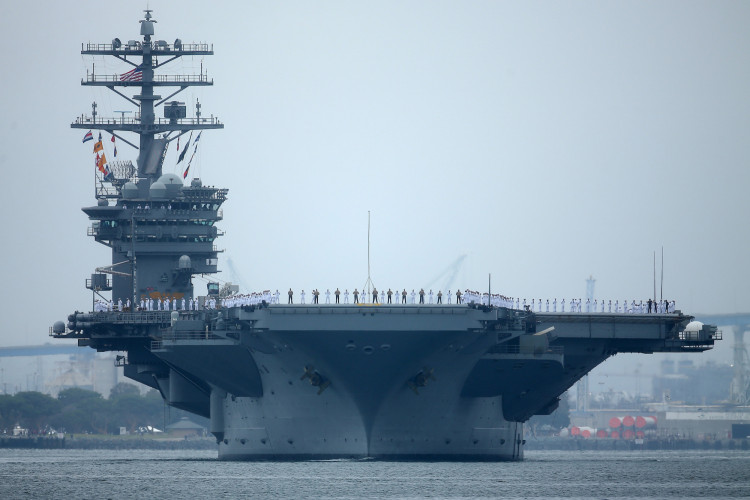In a show of military cooperation, the armed forces of five countries, including the United States, Japan, Australia, New Zealand, and the Philippines, conducted joint maritime exercises in the South China Sea over the weekend. These exercises took place in the Philippines' exclusive economic zone (EEZ), a portion of the highly contested waterway. The drills, which aimed to enhance interoperability between the nations, occurred just as China launched its own naval and air exercises in the disputed region.
The participating nations deployed a variety of military assets, including the United States' USS Howard, Japan's JS Sazanami, and New Zealand's HMNZS Aotearoa. The exercises highlighted the increasing military cooperation among the U.S. and its Asia-Pacific allies amid rising tensions over China's territorial claims in the South China Sea.
Australia's Department of Defence stated that the drills demonstrate "our collective commitment to strengthen regional and international cooperation in support of a peaceful, stable, and prosperous Indo-Pacific." This statement underscores the shared goal of maintaining freedom of navigation in a region through which half of the world's container ship traffic passes.
The backdrop to these joint exercises is the long-standing territorial disputes between China and several Southeast Asian nations. China claims sovereignty over almost the entire South China Sea, despite conflicting claims from the Philippines, Brunei, Malaysia, and Vietnam. One of the focal points of this dispute is the Scarborough Shoal, which lies just 200 kilometers off the Philippines' coast but has been under Chinese control for over a decade.
Chinese air and naval forces conducted their own drills in the region on Saturday, further intensifying the standoff. The People's Liberation Army (PLA) announced "routine" patrols and reconnaissance exercises near the Scarborough Shoal, declaring its intention to safeguard China's "national sovereignty, security, and maritime rights." The PLA maintained that their actions were defensive and aimed at preserving peace in the region.
These drills followed a high-level meeting between Chinese Foreign Minister Wang Yi and U.S. Secretary of State Antony Blinken in New York, where the two discussed ways to prevent an escalation in the South China Sea. However, tensions remain high, with both sides accusing each other of provocative actions.
In March, Blinken assured the Philippines that its defense partnership with the U.S. was "ironclad," following several incidents involving aggressive Chinese coast guard and militia vessels near Philippine waters. The Philippines, a longstanding U.S. ally, has repeatedly called on China to respect international maritime law, including the 2016 ruling by the Permanent Court of Arbitration in The Hague, which rejected China's broad territorial claims in the South China Sea. China, however, has ignored the ruling.
The exercises come at a time of heightened military activity in the region. Just days before the drills, naval vessels from Australia and New Zealand passed through the Taiwan Strait, a major international waterway that China claims as part of its own territorial waters. The U.S. and Taiwan, however, maintain that the strait is an international waterway and that China has no exclusive control over it.
China has consistently pressed its claims over the South China Sea and the Taiwan Strait, leading to frequent confrontations with U.S. and allied forces. Australian Foreign Minister Penny Wong, speaking at the United Nations General Assembly, reiterated Australia's position that peace and stability in the South China Sea are crucial. She also welcomed the resumption of dialogue between the U.S. and China, highlighting the importance of reducing tensions.
In response to the joint exercises, China has reiterated its commitment to defending its claims in the region. The PLA stated, "The theater troops maintain a high degree of vigilance, resolutely defending national sovereignty." Chinese officials have accused the U.S. of "stirring up trouble" and undermining the efforts of regional countries to maintain peace.
The strategic importance of the South China Sea cannot be overstated. It is a vital commercial artery for global trade and a flashpoint for military conflict, with more than 20,000 warship days logged annually by nations operating in the region. A Beijing-based think tank, the South China Sea Strategic Situation Probing Initiative, reported that U.S. Navy ships spent approximately 1,600 days at sea in the area last year.
China's presence in the South China Sea has increasingly drawn the attention of its neighbors and the international community. While the joint exercises with the U.S. and its allies aim to demonstrate a united front against Chinese expansionism, the situation remains volatile. The Philippines, in particular, has been vocal about the risks of an "accidental" confrontation between military forces that could escalate into a broader conflict.






